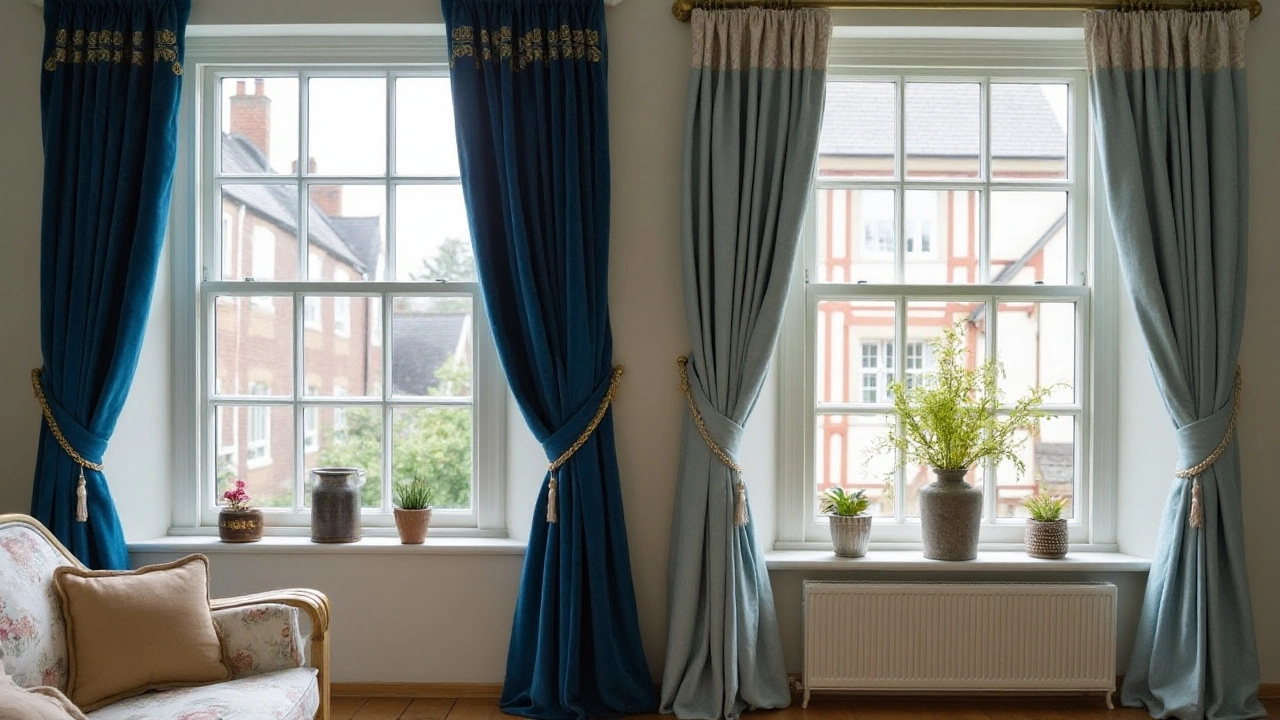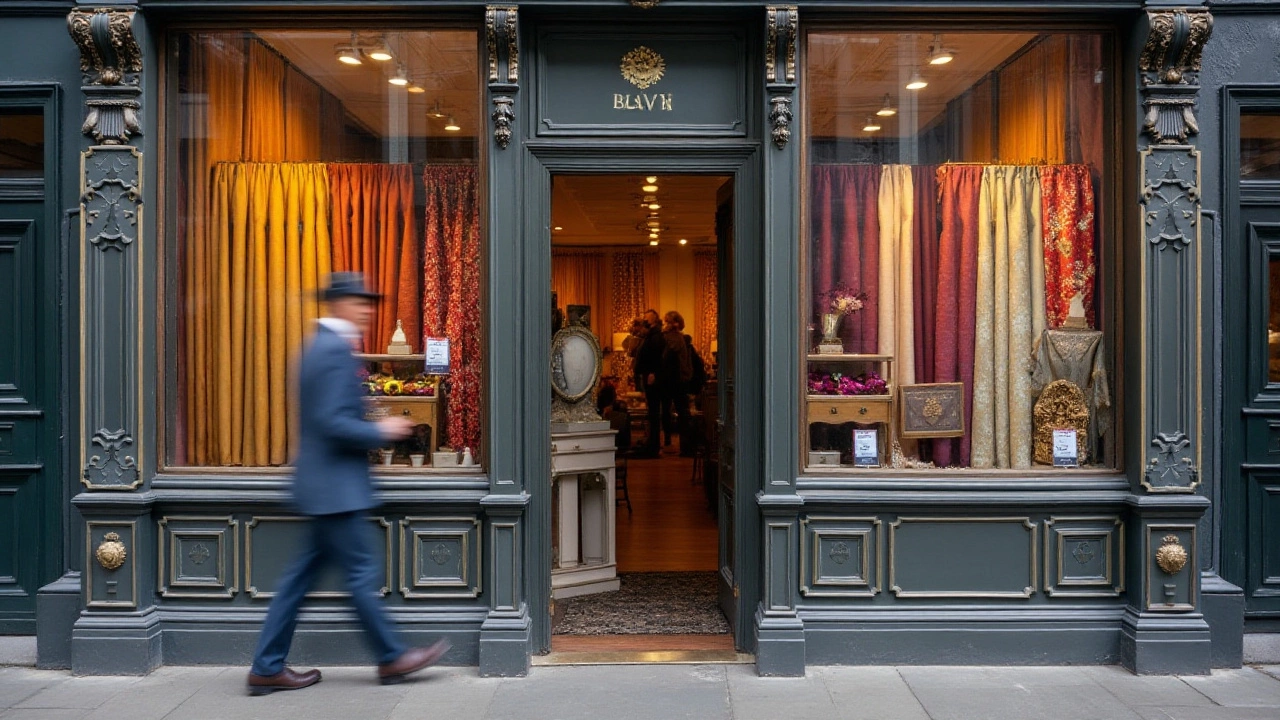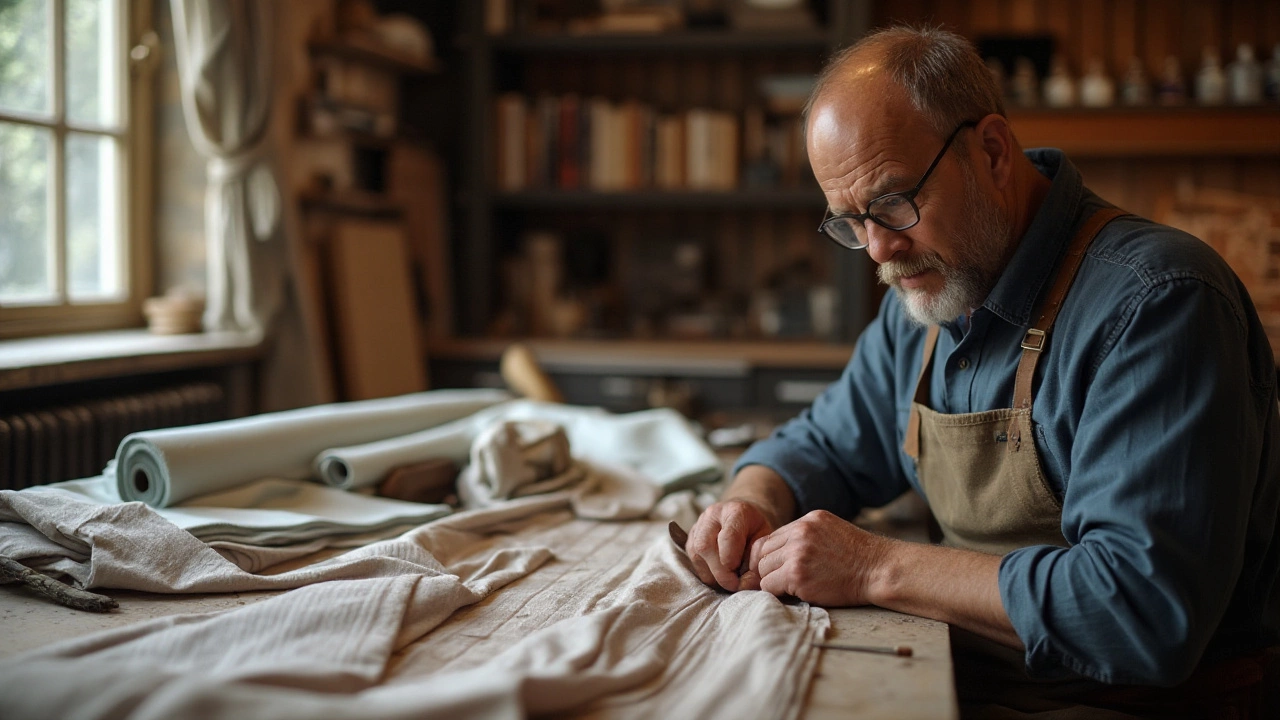Exploring the Cost Differences Between Drapes and Curtains
 Jan, 1 2025
Jan, 1 2025
In the world of home decor, choosing between drapes and curtains can seem like a small decision. However, the impact on your living space is anything but minor. Many homeowners wonder whether drapes cost more than curtains and, crucially, if the difference in cost is justified by the distinction in style or function.
Diving into the details, we explore what makes drapes and curtains unique, especially when it comes to their pricing. From the luxurious fabrics of drapes to the simplicity of curtains, each option has its charm and quirks. We'll also unravel some expert tips to help you make the most cost-effective choice without compromising on beauty or practicality.
- Differences Between Drapes and Curtains
- Cost Factors for Drapes
- Cost Factors for Curtains
- Tips for Budget-Friendly Window Treatments
- Making the Right Choice for Your Home
Differences Between Drapes and Curtains
When decorating a home, the choice between drapes and curtains often depends on both aesthetic preferences and functional needs. Although the terms are frequently used interchangeably, they refer to different kinds of window treatments. Understanding the differences can help homeowners make informed decisions that optimize both style and utility. Drapes are typically made from heavier fabrics compared to curtains and often feature lining, which adds to their cost and weight. This extra weight serves a purpose, as drapes are designed to block out light completely and offer superior insulation against external temperatures, making them an excellent choice for bedrooms or living areas where darkness and privacy are paramount.
In contrast, curtains are usually constructed from lighter fabrics, such as cotton or polyester, and may not have the lining or extensive pleating common to drapes. This makes curtains an excellent choice for spaces where natural light is embraced, such as kitchens, bathrooms, or casual living rooms. Due to their simpler construction and more accessible materials, curtains are generally more affordable than drapes, contributing to their widespread popularity. This affordability offers an opportunity for frequent updates, allowing decorators to easily change patterns and colors to refresh the space with each passing season.
Another significant difference between drapes and curtains lies in their installation and maintenance. While curtains can be easily mounted on a simple rod and require minimal effort to install, drapes often demand a more intricate setup with brackets and possibly a traverse rod for ease of opening and closing. This complexity not only increases the initial cost of drapes but also necessitates professional installation in many cases, contributing to the overall expense. A study from the National Home Design Institute once noted,
"Homeowners often overlook the impact of expertly installed drapery, which can transform a mundane room into a lush sanctuary."
Finally, the aesthetic impact of window treatments mustn't be underestimated. Drapes typically deliver a more formal and sophisticated look, suitable for traditional or classic decor styles, while curtains are associated with a more casual and approachable ambiance. This distinction affects how they integrate with existing furnishings and decor elements. Drapes come in a variety of pleating styles such as pinch pleats, goblet pleats, and grommet tops, adding to their elegance, whereas curtains may simply use rod-pocket or eyelet designs. Ultimately, choosing between the two involves considering a blend of cost, practical requirements, and the stylistic goals of the space being furnished.
Cost Factors for Drapes
When considering the expense associated with drapes, several elements play a crucial role in determining their price. One of the primary factors is the fabric quality. Drapes are often crafted from high-end materials such as silk, velvet, or brocade, which inherently carry a higher cost due to their luxurious nature and superior durability. These fabrics are hand-picked to provide a rich texture and aesthetic appeal, justifying the premium price for many homeowners. In contrast to more lightweight curtains, drapes not only offer privacy but also contribute significantly to thermal insulation, cutting down energy costs, a feature that adds value and desirability.
Customizability is another significant contributor to the cost of drapes. Unlike off-the-shelf curtains, drapes are frequently tailored to fit specific window dimensions, accommodating unique architectural features. This bespoke service often involves detailed measurements and consultations, adding to the total cost. Skilled craftsmen employ meticulous techniques to ensure that every pleat and seam aligns perfectly, elevating the window's appearance. According to a report in Home Textiles Today, "customization can increase drapery costs by up to 30%, encompassing specialized linings and decorative trims."
In the words of interior designer Sarah Nice, "Investing in high-quality drapes is akin to purchasing a piece of art; it transforms your space instantaneously, providing both style and substance."
Decorative trims such as tassels, fringes, and intricate embroidery also inflate the price. These embellishments require additional material and labor, adding to the complexity and exclusivity of drapes. The lining material chosen for drapes is another cost aspect often overlooked. Premium linings enhance the drapes' functionality by offering UV protection, increased privacy, and sound insulation. The choice between thermal, blackout, or standard lining can significantly affect the final price.
Installation is the final element impacting the cost of drapes. While many may prefer a quick DIY approach for curtains, installing drapes usually requires professional assistance. Due to their weight and size, drapes need robust mounting hardware and precise installation to prevent potential damage. Professional installation ensures that drapes hang correctly and function smoothly, which might appear as an upfront cost but saves money in avoiding future repairs.

Cost Factors for Curtains
When evaluating the cost of curtains, several elements play crucial roles. The material is perhaps the most significant determinant. Cotton and polyester are the most common fabrics, typically offering a budget-friendly pathway for those who do not wish to stretch their wallets. On the other hand, heavyweight textiles like velvet or silk elevate the cost considerably due to the luxurious feel and appearance they confer. In fact, a premium silk curtain can cost up to ten times more than a basic polyester alternative. Such a difference often reflects in aesthetics and longevity, where it's not just about the immediate appearance but the enduring impact on interior decor.
Size also matters significantly in cost considerations. Curtains tailored for expansive windows or lavish settings require more fabric and often involve additional customization charges. Standard-sized curtains are usually found more readily and tend to cost less. However, custom-sizing introduces a new dimension of personalization that might appeal to homeowners looking for exact fits without compromising the flow or aesthetic of a room. This customization comes at a price, quite literally, making it a less appealing option for those on tight budgets.
Another key factor is the type of accessories included. Grommets, hooks, and pleats not only affect the function and flow but also the final price. A grommet-headed curtain, for instance, provides ease of use and additional aesthetic appeal but often costs more due to the additional labor and material involved. Pleats, while giving a classic look, involve intricate sewing practices adding to the labor costs. Not to forget, curtain rods and other hardware, although often overlooked, contribute significantly to the overall expense when adding style or functionality.
An underappreciated aspect of curtain cost is the brand and designer level. Well-loved designer brands can command premium prices for their uniqueness, quality materials, and craftsmanship. Alternately, off-brand curtains from a standard retailer might offer affordability but often at the expense of quality and longevity. For instance, buying from a designer such as Thomas O'Brien might come with a premium, but those pieces often carry warranties and service guarantees, building trust and long-term satisfaction.
The marketplace shift toward sustainability also influences the curtain cost. Eco-friendly fabrics such as organic cotton or those made from recycled materials often carry a slight markup, reflective of their environmental benefits. The movement toward sustainable living has urged many consumers to opt for such fabrics, accepting the slightly higher prices for the peace of mind they offer. According to Green Home Magazine, "Investing in sustainable materials not only supports the planet but often delivers a longer-lasting product that's worth every penny."
In today's market, the options for curtains are as variable as they are plentiful. Understanding these cost factors helps in making informed choices, aligning both budgetary constraints and stylistic aspirations. The exploration of fabric, size, additional details, and even the brand play integral parts in the balance between cost and value, ensuring that the choices made cater to personal taste without overshooting the feasible financial boundaries.
Tips for Budget-Friendly Window Treatments
Transforming your living space doesn't have to come with a hefty price tag. When choosing between drapes and curtains, or any other window treatments, there are several strategies to keep costs low while still achieving a stylish look. One must start by assessing the existing decor and understanding the ambiance you wish to create. This will help you avoid unnecessary purchases and focus on what complements your setting seamlessly. A simple and effective way to save money is by repurposing materials you already have. Old linens, for example, can be transformed into chic curtains with a bit of creativity and a sewing machine.
Choosing the right materials can dramatically impact your budget. While it might be tempting to go for the lush, thick fabrics often associated with drapes, lightweight and less expensive fabric can be just as effective. Cotton or polyester blends offer durability without sacrificing appeal. If you have a knack for DIY projects, there are plenty of online tutorials that provide step-by-step guidance on crafting your own window treatments from scratch. This not only saves you money but also allows for a custom fit and design tailored to your personal taste and home's specific needs.
Elegant Simplicity: The Power of Minimalist Design
Adopting a minimalist approach can also translate into savings. Simplicity is inherently elegant, and often, less is more. Instead of elaborate designs, consider a sleek and simple look that is timeless and sophisticated. A minimalist approach not only lowers costs but also allows you to update the room's look by simply changing a few accessories or adding a splash of color. The use of neutral colors in window treatments can create a serene and airy feel, giving the illusion of more space, which is often highly desirable in smaller homes or apartments.
"Design is intelligence made visible." — Alina Wheeler
For those keen on adding a touch of luxury without the high price point associated with traditional drapes, consider seeking out discount fabrics or remnants, often sold at a fraction of the cost at fabric stores. These remnants can usually cover small to medium-sized windows effectively. Thrift stores and online marketplaces are also excellent sources for budget-friendly finds that offer character and uniqueness. Repurposing vintage fabrics can create statement pieces that are one-of-a-kind, adding charm and a sense of history to your space.
Utilizing Layering Techniques
Layering is another wonderful method to achieve a designer look on a tight budget. By mixing materials and patterns, you can add depth and interest to your window treatments. Pairing sheer curtains beneath a heavier curtain allows for versatility, letting in natural light during the day while offering privacy at night. This approach not only enhances the aesthetic appeal but can also make temperature regulation more efficient, potentially cutting down on heating and cooling costs. Feel free to experiment with diverse textures and colors that accentuate other elements within your room, creating a cohesive and inviting atmosphere.
| Material | Cost per Yard | Durability |
|---|---|---|
| Cotton | $5 - $10 | High |
| Polyester | $3 - $8 | Very High |
| Linen | $10 - $20 | Medium |
Lastly, don't forget the impact of maintenance on your budget. Opt for materials that are easy to clean and maintain, as regular dry cleaning costs can add up quickly. Machine-washable curtains are an excellent choice for those who want low maintenance costs. With the right approach and a bit of creativity, you can easily find the perfect window treatment that aligns with both your aesthetic and financial goals.

Making the Right Choice for Your Home
When deciding between drapes and curtains, it’s important to take a good look at your personal style, your home's unique needs, and of course, your budget. First off, consider the ambiance you want to create. If you’re looking for a traditional and elegant feel, rich velvet drapes might steal your heart. They're known for their grand impact and ability to add sophistication, instantly transforming a room’s decor. Compare this to the breezy and light-hearted ambiance created by sheer curtains, ideal for casual, airy spaces.
Another critical factor is functionality. Drapes, often thicker and heavier than curtains, provide excellent insulation and can block out light more effectively, which is essential for those who value privacy or want to improve energy efficiency in their homes. This makes them perfect for bedrooms where blackout features are a prize or living areas that face the sun. In contrast, curtains tend to allow more light through, offering a softer diffusion perfect for rooms where natural sunlight is appreciated, like kitchens or playrooms.
Don’t overlook maintenance. Drapes can demand more care due to their weight and material. Frequent cleaning might require professional services which can add to their total cost over time. On the flip side, curtains, being lighter, are usually more manageable when it comes to washing and maintenance. Their materials often lend themselves to straightforward at-home care, which is a significant boon for busy homeowners.
When on a budget, the price can be the deciding agent. Here, curtains typically have the advantage. They are usually more affordable upfront as they require less fabric and simpler construction. For those wanting the drape look without the price tag, consider doubling curtain panels for an effect of fullness, or opt for curtain styles that mimic the layered look of drapes.
Finally, remember to factor in installation. Custom-made drapes may necessitate additional expenses like special hardware or installation fees, which might not be the case with store-bought curtains. Keep an eye out for deals and offers; some retailers offer free installation for purchases over a certain amount, which can significantly lower costs. As the saying by the renowned interior designer David Hicks goes,
“The best rooms have something to say about the people who live in them.”Choose what resonates most with your style and convenience while ensuring it mirrors your taste.
A glance at these elements can effectively guide your choice between drapes or curtains, ensuring your window treatment perfectly complements both your interior design and functional needs.